
95% of researchers rate our articles as excellent or good
Learn more about the work of our research integrity team to safeguard the quality of each article we publish.
Find out more
REVIEW article
Front. Pharmacol. , 13 February 2025
Sec. Translational Pharmacology
Volume 16 - 2025 | https://doi.org/10.3389/fphar.2025.1553158
This article is part of the Research Topic Pharmaceutical Biomaterials View all 31 articles
Photothermal therapy (PTT), a popular local treatment that uses heat to ablate tumors, has limited efficacy in addressing metastatic and deeply located tumors when used alone. Integrating PTT with immunotherapy not only yields a synergistic effect but also promotes cancer regression and confers the benefit of immune memory, which can surmount the challenges faced by PTT when used in isolation. Metal-based nanomaterials, renowned for their superior photothermal conversion efficiency and distinctive photochemical properties, have been extensively researched and applied in the field of PTT. This review summarizes the latest developments in combination therapies, with a specific focus on the combination of PTT and immune checkpoint therapy (ICT) for cancer treatment, including a comprehensive overview of the recent advancements in noble metal-based and 2D transition metal chalcogenides (TMDCs)-based photothermal agents, and their anticancer effect when combining PTT with immune checkpoint blockades (anti-CTLA-4 and anti-PD-L1) therapy. The goal of this review is to present an overview of the application, current challenges and future prospects of metal-based photothermal agents in PTT combined with ICT for cancer treatment.
Cancer is one of the most leading causes of death worldwide, in 2022, nearly 20 million new cancer cases were diagnosed, and approximately 10 million people died from the disease (Bray et al., 2024). It is projected that about one in five individuals will develop cancer, with one in nine men and one in twelve women succumbing to it. The primary therapeutic approaches for cancer management include surgery, chemotherapy, radiotherapy, and other methods (Debela et al., 2021; Liu B et al., 2024). However, these traditional treatments have several limitations and can cause significant side effects, which make it necessary to explore more safety and effective treatment strategies for cancer treatment.
Photothermal therapy (PTT) is a local treatment that uses photothermal agents (PTAs) to harvest energy from near-infrared (NIR) light and convert the energy into heat, which leads to an increase in the temperature surrounding the tumor tissue ultimately inducing the death of cancer cells (Yang et al., 2016; Liu et al., 2018; Nam et al., 2018; Gao et al., 2022). At present, the photothermal agents mainly include noble metal nanomaterials (Wang et al., 2012; Ding et al., 2021), graphene (Lin et al., 2020; Li L et al., 2024), two-dimensional transition metal chalcogenides (TMDCs) (Gong et al., 2017), semiconducting polymer nanoparticles (Zhang Y et al., 2018), organic small molecule dyes and so on, some of these summarized in Table 1. Among these photothermal agents, noble metal-based and TMDCs-based photothermal agents possess numerous advantageous characteristics, including high photothermal conversion efficiencies and unique electronic and optical properties (Hernández and Galarreta, 2019; Zhang X. et al., 2019). Moreover, their large surface area and low cytotoxicity facilitate the entry of biomolecules and drugs into cells, which is crucial for effective cancer therapy (Gong et al., 2017; Yang F et al., 2024). This treatment modality has a high degree of controllability in the treatment of tumors, and can also produce a large number of relevant antigens when eliminating the primary tumor. At the same time, as a non-invasive therapeutic method, PTT has the advantages of high specificity, low side effects, and high photothermal conversion efficiency, exhibiting a good ablation effect on solid tumors (Ban et al., 2017; Zhang et al., 2021; Kong and Chen, 2022). Therefore, it is widely favored by scientific researchers.
However, due to the limited penetration of light in tissues and inefficacy target ability to tumor site, the use of photothermal therapy alone will face problems such as low thermal ablation efficiency of primary tumors in deep tissues and unsatisfactory treatment effect for diffuse metastatic tumors (Chu and Dupuy, 2014; Deng et al., 2021). Therefore, scientists are working on strategies to combine photothermal therapy with other treatments. At present, the combination of PTT with photodynamic therapy (PDT), chemotherapy and immunotherapy are widely studied (Li et al., 2020; Huang et al., 2021; Liu et al., 2022; Li S et al., 2024). The absorption spectra of photodynamic and photothermal agents often do not align, which requires the use of two different lasers for long-term combination treatments involving PTT and PDT, further complicating the treatment process (Yang et al., 2017; Younis et al., 2019). The combination of PTT with immunotherapy effectively addresses the aforementioned issues while also overcoming the challenges of possible resistance to chemotherapy drugs. Therefore, researchers are committed to studying the combination of photothermal therapy and immunotherapy.
In recent years, immunotherapy has emerged as a promising cancer treatment option for individuals seeking to leverage their own immune system against diseases, particularly for those with uncontrollable cancers (Tan et al., 2020; Zhang and Zhang, 2020; Li et al., 2023; Liu Y et al., 2024). Tumors utilize multiple strategies to avoid immune detection, including the activation of regulatory T cells and the induction of inhibitory checkpoint receptors (Gajewski et al., 2013). Immune checkpoint proteins, including cytotoxic T lymphocyte-associated molecule-4 (CTLA-4) and programmed cell death ligand-1 (PD-L1) which are able to cause T cells with tumor-killing inactivation and promotion of cancer cell growth and invasion. Thus, the immune checkpoint blockades (ICBs), anti-CTLA-4 and anti-PD-L1, have been employed to suppress malignant tumors and have significantly improved patient survival rates (Doroshow et al., 2021; Matias et al., 2021). However, the eradication of the primary tumor through single immunotherapy remains a significant challenge, especially due to the considerable antigenic variation observed across different cancers (Copier and Dalgleish, 2006; Shao et al., 2015). In addition, PTT not only generates endogenous tumor-associated antigens (TAAs) during thermal ablation of primary tumors, but also generates damage-associated molecular patterns (DAMPs) and induces immunogenic cell death (ICD) in tumors. TAAs enable personalized and specific immunotherapy, and ICDs can awaken the immune system and enhance the immunogenicity of tumors (Guo et al., 2022; Zhuang et al., 2023). Therefore, the combination of immunotherapy with PTT is the most promising strategy to overcome the limitations of monotherapy (Wu et al., 2022b). In this review, we will summarize the recent application in the synergistic treatment of cancer with mental-based PTT and immune checkpoint therapy (ICT). We hope this review can provide a comprehensive status of mental-based PTT combined ICT for further development, and contribute to the early clinical translation of metal-based photothermal agents.
Over the past decades, a multitude of immune checkpoint proteins have been identified and studied, including programmed cell death protein-1 (PD-1)/PD-L1, CTLA-4, lymphocyte-activation gene 3 (LAG3), T cell immunoglobulin and mucin domain containing-3 (TIM3), T cell immunoreceptor with Ig and ITIM domains (TIGIT), and B- and T-lymphocyte attenuator (BTLA) (He and Xu, 2020). Normally, these immune checkpoints could protect normal cells from damage through activating the immune system to resist the malignancies and infections (Marin-Acevedo et al., 2018). However, in tumor cells, PD-1/PD-L1 and CTLA-4, the most broadly studied immune checkpoints, lead to T cells with tumor-killing inactivation and promote tumor cells growth and invasion (Figure 1A) (Jiang et al., 2021; Liu et al., 2021; Song et al., 2021; Sun S et al., 2021; Yang et al., 2024). As shown in Figure 1B, CTLA-4 combines with CD80 and CD86 ligands on dendritic cells (DCs) to deliver an inhibitory signal, which regulates the expression of Treg cells, an immunosuppressive T cell, and inhibits T cell immune response activation. Besides, the PD-L1 in cancer cells combines with PD-1, expressed on T cells, prevents the T cells from killing cancer cells, causing the immune escape of tumor cells (Filin et al., 2020). Therefore, the immune checkpoint blockades (ICBs), anti-CTLA-4 and anti-PD-L1, can enhance antitumor immunity through disrupting the tumor co-inhibitory immune cells. Although ICT is an effective strategy to activating T cells and promoting anti-tumor immune responses, if the number of immune cells is low or non-existent in the tumor microenvironment, it will diminish the therapeutic effect of ICBs (He and Xu, 2020). Photothermal therapy (PTT), using photothermal agents to generate heat under laser irradiation, can induce ICD in tumors to promote T cells infiltration. Therefore, combining PTT with ICB treatment can enhance immune cells infiltration in tumor and prevent tumor metastases. A comprehensive summary of the noble metal-based and 2D TMDCs-based photothermal agents in PTT combined with ICT are showed in Table 2.
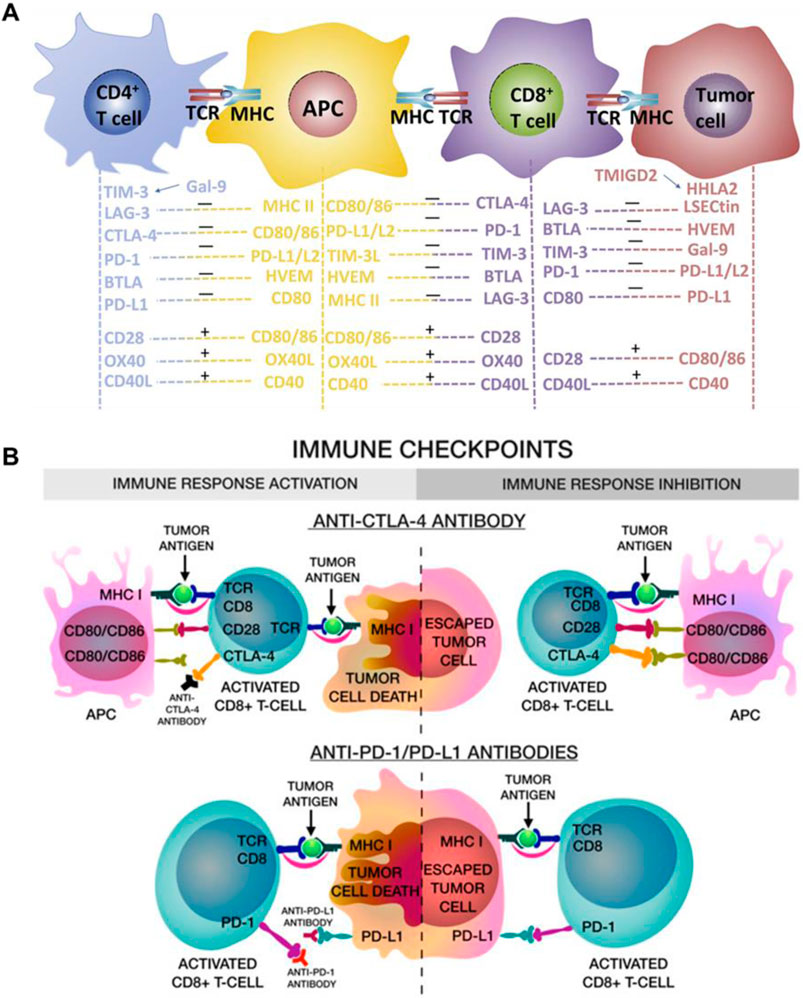
Figure 1. Immune checkpoints blockade (anti-CTLA-4 and anti-PD-L1) enhanced the immune cells activation and eradicate tumor cells. (A) The schematic illustration of the multi-signal processes of T-cell activation and inactivation. Reproduced with permission from Ref (Jiang et al., 2021). Copyright 2019 Chongqing Medical University. Production and hosting by Elsevier B.V. (B) The schematic illustration of anti-CTLA-4 blocks the binding of CD80/CD86 in APC cells, thus activated CD8⁺ CTLs can inhibit tumor cells proliferation, and the anti-PD-L1 blocks the binding, leading to tumor cells be killed by CD8+ T cells. Reproduced with permission from Ref (Filin et al., 2020). Copyright 2020 by the authors.
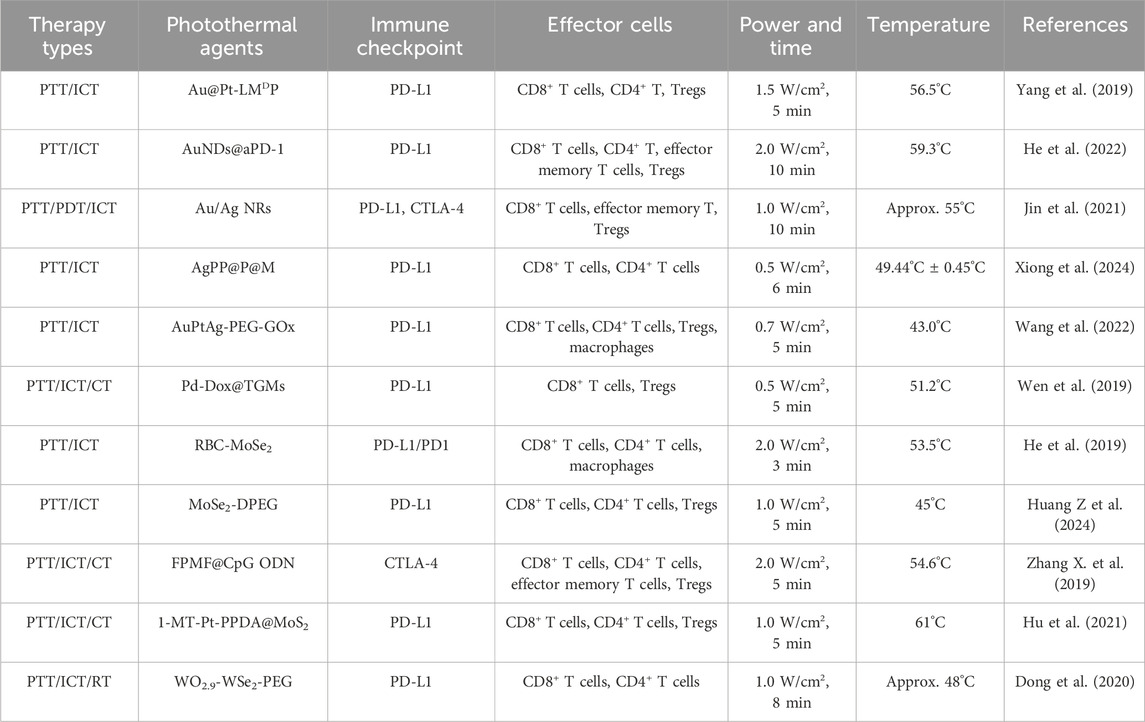
Table 2. The summary of noble metal-based and TMDCs-based photothermal agents in PTT combined with ICT.
Noble metals, primarily consisting of gold, silver, platinum and palladium, not only possess synthetic tunability and strong localized surface plasmon resonance (LSPR) effects (Jahangiri-Manesh et al., 2022; Yu et al., 2024) but also have superior optical and photothermal properties. Based on the aforementioned outstanding properties of noble metal, noble metal-based nanomaterials are widely used in PPT for cancer treatment.
Gold nanomaterials are the most widely studied noble metal photothermal agents, due to their outstanding photostability, high biocompatibility, and considerable photothermal conversion efficiency (Gui et al., 2021; Shuai et al., 2023). In order to endow gold-based nanomaterials with targeting and controlled drug release, Yang et al. combined Au@Pt nanoparticles with the antagonist LMDP peptide to form a multifunctional nanosystem (Au@Pt-LMDP) (Yang et al., 2019). As shown in Figures 2A, B, the LMDP peptide consists of a three-part combination including a PD-L1 antagonist short D-peptide (DPPA-1), a MMP2-reactive peptide (PLGVRG) and LyP-1 (CGNKRTRGC) sequence identical to tumor homing ligand, which endow Au@Pt-LMDP with high tumor inhibition and the alleviation of metastasis, especially the lung metastasis, via enhancing population of the CD8+ T cells and downregulating the Treg activity when combination with PTT. Besides, He et al. prepared AuNDs@aPD-1, which not only exhibits long-term retention of drugs and enhancing the tumor-targeting ability, but also efficiently promotes the activation of antitumor CD4+ and CD8+ T cells, and inhibit the Treg cells activity in tumor when combined with PTT, showing significant anticancer ability to local as well as distant tumors (Figures 2C, D) (He et al., 2022).
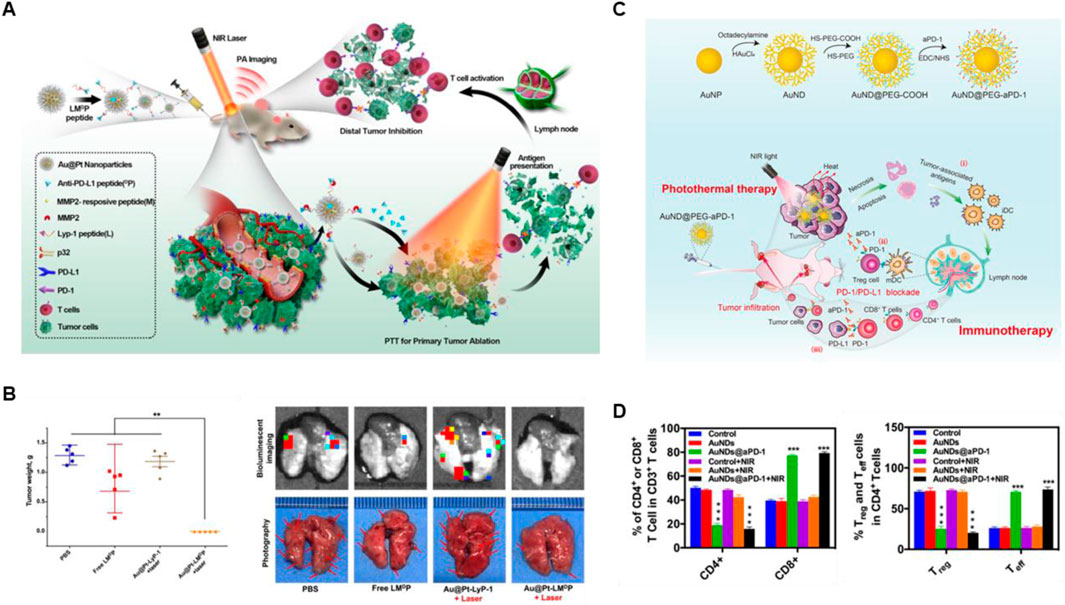
Figure 2. Gold-based nanomaterials combined with PTT and ICBs enhanced the anticancer ability. (A) The schematic illustration of Au@Pt-LMDP combined with photothermal and immunotherapy. (B) The weights of tumors and the bioluminescent imaging of the metastatic foci of 4T1 lung metastatic tumors at the end of treatments. Reproduced with permission from Ref (Yang et al., 2019). Copyright 2019, Elsevier B.V. All rights reserved. (C) The schematic illustration of AuNDs@aPD-1 in photothermal therapy combined with immune checkpoint therapy in vivo. (D) The quantitative analysis of CD4+ T cells, CD8+ T cells, Treg cells and Teff cells in tumor at the end of treatments were detected by Flow cytometry. Reproduced with permission from Ref (He et al., 2022). 2022, Elsevier Ltd. All rights reserved.
Silver nanomaterials have been used in the field of PTT for their low toxicity, easy preparation, tunable SPR band, and superior thermal conductivity compared to other metals (Boca et al., 2011). Jin et al. found that a corn-like Au/Ag nanorod (NR) combination with 1,064 nm laser irradiation obviously increased the tumor infiltration of T cells after the injection of anti-PD-1 or anti-CTLA4, indicating a strong immunological memory effect and high anticancer ability (Figures 3A, B) (Jin et al., 2021). Moreover, in order to effective target the tumor site and realize the controllable TME-responsive drug release, Xiong et al. constructed Ag2S QDs/PTX/α-PD-L1@PLGA@membrane (AgPP@P@M) NPs, which exhibited superior antitumor ability and lung metastases inhibition for primary TNBC by enhancing ICD and activating the activity of CD4+ and CD8+ T cells, suggesting excellent synergistic therapeutic effects combined PTT with ICB (Figure 3C) (Xiong et al., 2024).
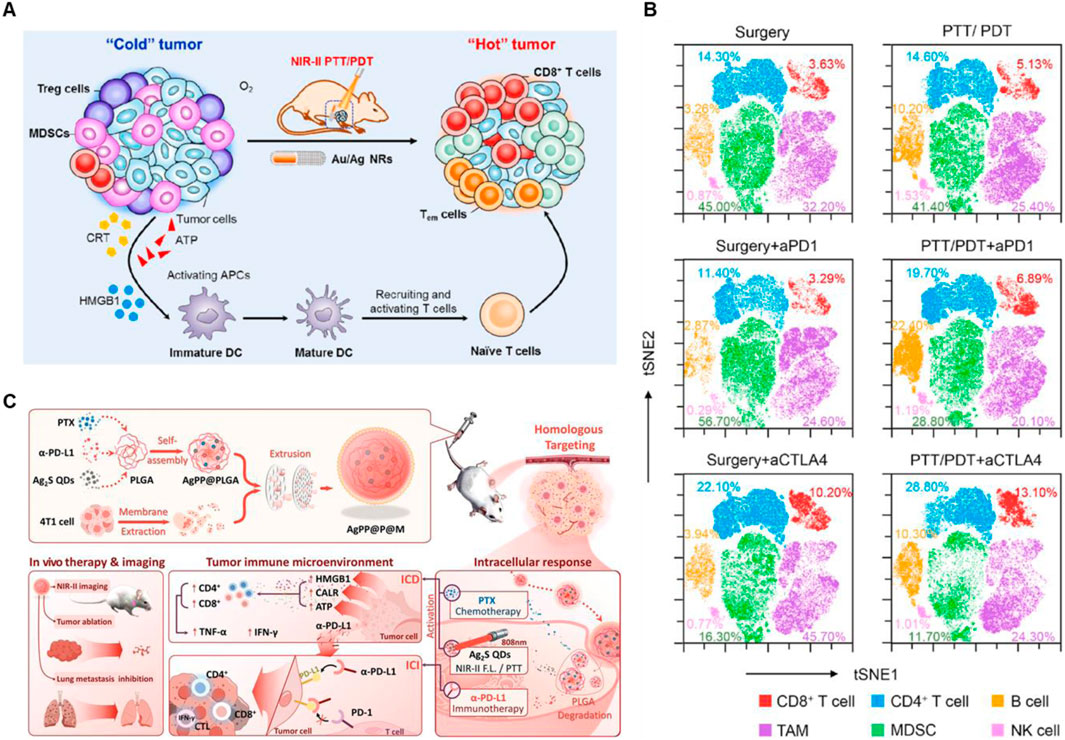
Figure 3. Silver-based nanomaterials combined with PTT and ICBs enhanced the anticancer ability. (A) Schematic illustration of anticancer immune responses induced by Au/Ag NR combined with NIR-II PTT/PDT. (B) t-SNE analysis of immune cells in tumors at the end of treatment. Reproduced with permission from Ref (Jin et al., 2021). Copyright 2020, Elsevier Ltd. All rights reserved. (C) Schematic illustration of AgPP@P@M NPs enhanced immunotherapy in vivo. Reproduced with permission from Ref (Xiong et al., 2024). Copyright 2024, Wiley-VCH GmbH.
Platinum nanoparticles with properties including DNA damage (Manikandan et al., 2013), antioxidant activity (Wang et al., 2023) and light absorption in the biological range (Depciuch et al., 2020) show high potential for use as effective photosensitizers in PTT. In addition, platinum nanoparticles can also be used in combination with photoacoustic imaging, magnetic resonance imaging and immunotherapy due to its excellent photo and thermal stability (Zhao et al., 2017). As demonstrated in Figures 4A, B, Wang et al. constructed AuPtAg-PEG-GOx nanozyme by a one-step method, which showed a broad absorption band in the near-infrared (NIR) region and higher CAT-like activity (Wang et al., 2022). More importantly, AuPtAg-PEG-GOx can effectively reprogram “cold” tumors into “hot” tumors through enhancing the expression of M1 macrophages in tumors after combination with 1,064 nm laser irradiation and anti-PD-L1, and increasing the ratio of DC maturation in lymph nodes, CD4+ and CD8+ T cells activation in spleen as well as inhibiting the proportion of Treg cells, showing high tumors inhibition.
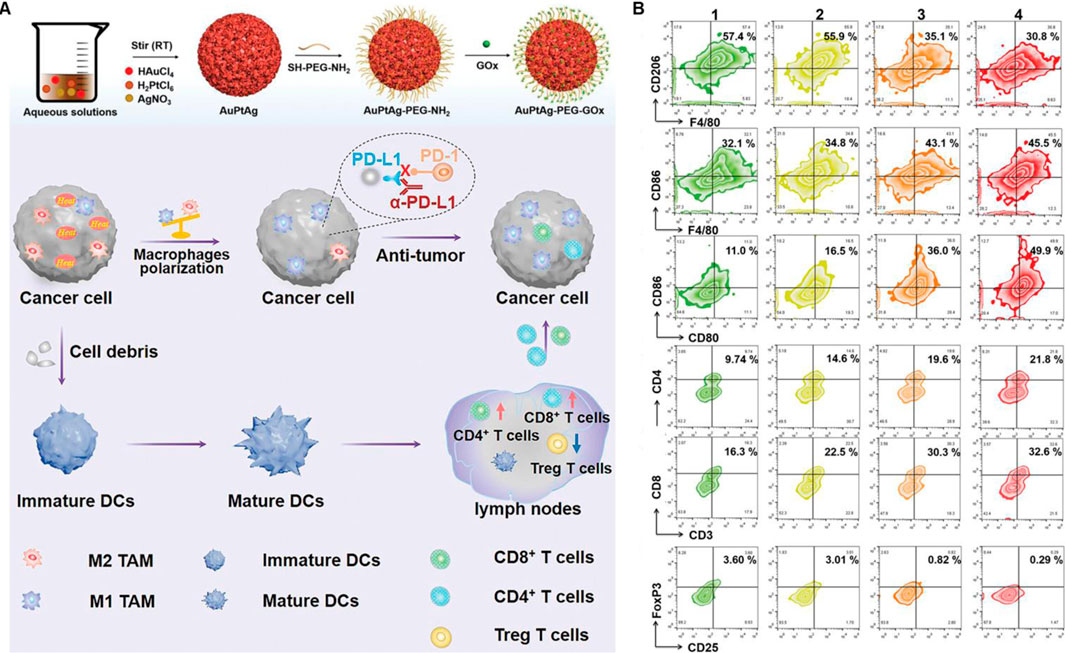
Figure 4. Platinum-based nanomaterials combined with PTT and ICBs enhanced the anticancer ability. (A) Schematic illustration of the AuPtAg-PEG-GOx nanozyme combined with 1,064 nm laser irradiation and anti-PD-L1 in vivo. (B) Flow cytometric analyses of the populations of M2 and M1 macrophages in tumor, DC cells in lymph nodes as well as CD4+ T cells, CD8+ T cells, and Treg in spleen. Reproduced with permission from Ref (Wang et al., 2022). Copyright 2022, The Authors. Advanced Science published by Wiley-VCH GmbH.
Palladium-based nanomaterials have been used in chemotherapy (CT), photodynamic therapy (PDT) and PTT due to its high catalytic activity in the presence of hydrogen peroxide, which facilitates the formation of oxygen molecules, thereby enhancing the efficiency of various cancer treatment (Wei et al., 2018; Zhang J et al., 2018; Singh et al., 2023; Yin et al., 2023; Lakkakula et al., 2024). Moreover, it has been demonstrated that palladium-based nanomaterials used in synergy with PPT and ICT can effectively activate the immune response to suppress tumor growth and metastasis. For instance, Wen et al. constructed Pd-Dox@TGMs NPs with an excellent inhibitory effect on CT26 tumor cells due to the synergistic therapy of CT and PTT, which cause ICD in CT26 cells (Figure 5A) (Wen et al., 2019). In addition, as shown in Figures 5B, C, the nanosystem could effectively trigger CD8+ T cells and suppress the tumor growth in the CT26 lung metastatic model when combining with anti-PD-L1. The Pd-Dox@TGMs NPs demonstrate remarkable antitumor properties of palladium-based photothermal agents when combining with PTT and ICT, however, there is still a dearth of research in this area for other palladium-based photothermal agents.
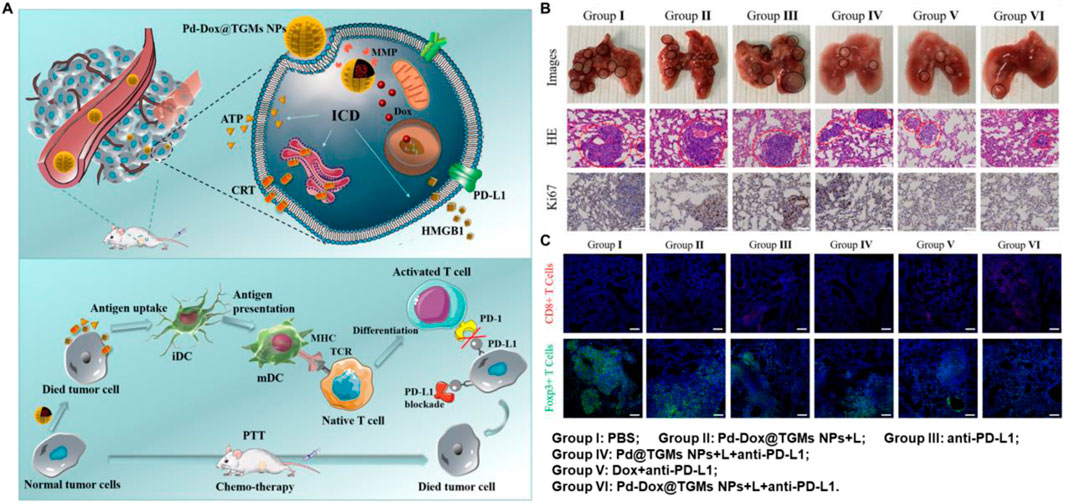
Figure 5. Palladium-based nanomaterials combined with PTT and anti-PD-L1 enhanced the anticancer ability. (A) Schematic illustration of the Pd-Dox@TGMs NPs nanozyme combined with 808 nm laser irradiation and anti-PD-L1 in vivo. (B) The pictures of lungs and staining of H&E and Ki67 in lung sections at the end of treatment. (C) The infiltration of CD8+ T cells and Tregs in lung sections after treatment. Reproduced with permission from Ref (Wen et al., 2019). Copyright 2019, American Chemical Society.
In conclusion, although the gold, silver, platinum and palladium-based metal photothermal agents have exhibited effectively anticancer ability in vitro and in vivo when combined PTT with ICT, high price, poor targeting specificity to tumor tissue, complex synergistic therapy processes and other shortcomings remain to be overcome.
Two-dimensional nanomaterials exhibit high NIR absorption ability, photothermal conversion efficiency and surface area, which hold huge potential for drugs delivery and photothermal tumor treatment (Wu et al., 2022a). Among many two-dimensional nanomaterials, the extremely high surface area of two-dimensional transition metal disulfide compounds (2D TMDCs) is able to attach a variety of nanoparticles and fluorescent probes for integration with other functional moieties, giving them richer properties than other 2D nanomaterials. The structure of TMDCs is mainly composed of two chalcogen atoms X (such as S, Se, Te) and a transition metal atom M (such as V, Ti, Nb, Mo, Zr, Co., Hf, Mn, Ta, etc.) to form a sandwich-like X-M-X (MX2) structure (Gong et al., 2017; Jiang et al., 2022; Mondal and De, 2024). In recent years, the combined anticancer advantage of 2D TMDCs have also gained more attention in the area of biomedicine because of its excellent properties with low toxicity, improving therapeutic efficacy and overcoming multi-drug resistance (MDR), which was shown in Figure 6 (Gong et al., 2017). So far, 2D TMDCs, such as MoS2, WS2, MoSe2 and WSe2 have been extensively studied for synergistic therapy, including photothermal therapy/photodynamic therapy (PTT/PDT) (Liu et al., 2014; Jia et al., 2017; Liu et al., 2020; Zhao et al., 2024), photothermal therapy/chemotherapy (PTT/CT) (Long et al., 2020; Gao et al., 2021; Chen et al., 2023; Xie et al., 2023), photothermal therapy/radiation therapy (PTT/RT) (Wang et al., 2016; Qi and Liu, 2019) and photothermal therapy/gene therapy (PTT/GT) (Kim et al., 2016; Zhang et al., 2016). However, there are relatively few studies focusing on PTT combined with ICT using 2D TMDCs as photothermal agents. Therefore, three 2D TMDCs (MoSe2, MoS2 and WSe2), which have demonstrated a high capacity to activate immune cells and realize effective tumor eradication, are introduced as follow.
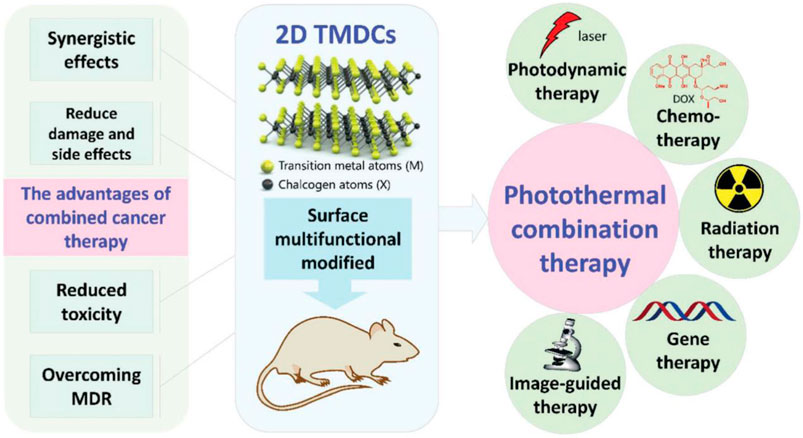
Figure 6. The advantages of 2D TMDCs combined with photothermal therapy. Reproduced with permission from Ref (Gong et al., 2017). Copyright 2017, Royal Society of Chemistry All rights reserved.
MoSe2 is considered as a promising 2D TMDCs for its narrow band gap (∼1.05 eV), considerable layer spacing (∼0.65 nm), excellent biocompatibility and highly efficient NIR-II absorption (Yuwen et al., 2016; Jiang et al., 2022). He et al. developed two-dimensional MoSe2 nanosheets with high photothermal conversion efficiency through employing a liquid exfoliation method (He et al., 2019). As shown in Figures 7A–C, hemocompatibility and circulation time were enhanced by coating two-dimensional MoSe2 nanosheets with red blood cell (RBC) membranes, which had excellent photothermal conversion efficiency to prevent macrophage phagocytosis. In addition, the RBC-MoSe2 combined with 808 nm laser irradiation and PD-1 checkpoint-blockade exhibited higher tumor ablation through CD4+ T cells activation in primary tumor and reprogramming the tumor-associated macrophages to tumoricidal M1 phenotype. Similarly, Huang et al. constructed MoSe2-DPEG nanosheets, which performance high PTT synergizing with anti-PD-L1, thus efficient depleting GSH, improving the response of ICB and stimulating CD8+ T cell-mediated systemic antitumor immune responses (Figures 7D, E) (Huang Z et al., 2024). However, circulating tumor cells (CTCs), detaching from the primary tumor tissue and entering bloodstream, are vital for the development and progression of lung cancer, based on this, Huang et al. constructed a PD-L1-MFP NS nanosystem, which is based on MoSe2 as a core and Fe3O4 as a functional magnetic material encapsulated with PDA coating in combination of anti-PD-L1 (Huang H et al., 2024). The nanosystem is able to enrich CTCs by an outer magnetic field and killing the captured CTCs under the irradiation of NIR laser. Furthermore, the nanosystem was also able to activate the expression of the surface ligands of NKG2D, enabling NK cells to kill CTCs, further preventing CTCs from undergoing immune escape.

Figure 7. MoSe2-based nanomaterials combined with PTT and ICBs enhanced the anticancer ability. (A) Schematic illustration of RBC-MoSe2 nanosheet combined with 808 nm laser irradiation and anti-PD-L1, which efficiently enhanced photothermal-triggered cancer immunotherapy. Flow cytometric analyses of the CD8+T cells in primary tumor (B) and the CD4+ T cells in spleen (C) at the end of different treatment. Reproduced with permission from Ref (He et al., 2019). Copyright 2019, WILEY-VCH Verlag GmbH and Co. KGaA, Weinheim. (D) Schematic illustration of MoSe2-DPEG combined with 1,270 nm laser irradiation and anti-PD-L1 in vivo. (E) The quantitative analysis of CD8+ T cells in primary and distant tumor, and the Treg cells in distant tumor. Reproduced with permission from Ref (Huang H et al., 2024). Copyright 2024, American Chemical Society.
In recent years, MoS2 has been reported and rapidly employed as a photosensitizer carrier or photothermal agent due to its excellent biocompatibility and high photothermal properties (Wang et al., 2024). For example, Zhang et al. designed multifunctional FPMF@CpG ODN NCs, which was consist of folic acid (FA), FePt, MoS2, oligodeoxynucleotides containing cytosine-guanine (CpG ODNs) and anti-CTLA4 antibody (Zhang D. et al., 2019). The FPMF@CpG ODN NCs exhibited higher synergistic photo-chemo-immunotherapy for cancer due to the highly effective photothermal conversion of MoS2 nanosheets, overproduction of ROS induced by FePt, and the increase immune cells activated by CpG ODNs and CTLA4 (Figures 8A, B). In addition, in order to monitor the tumor treatment real time, Hu et al. constructed 1-MT-Pt-PPDA@MoS2 complexes, with excellent multimode complementary CT/PA/thermo imaging. Furtherly, the complexes could obviously inhibit the tumor growth via the synergistic photothermo-chemotherapy and activation of T cell-mediated immunotherapy to realize complete tumor eradication (Figures 8C, D) (Hu et al., 2021).
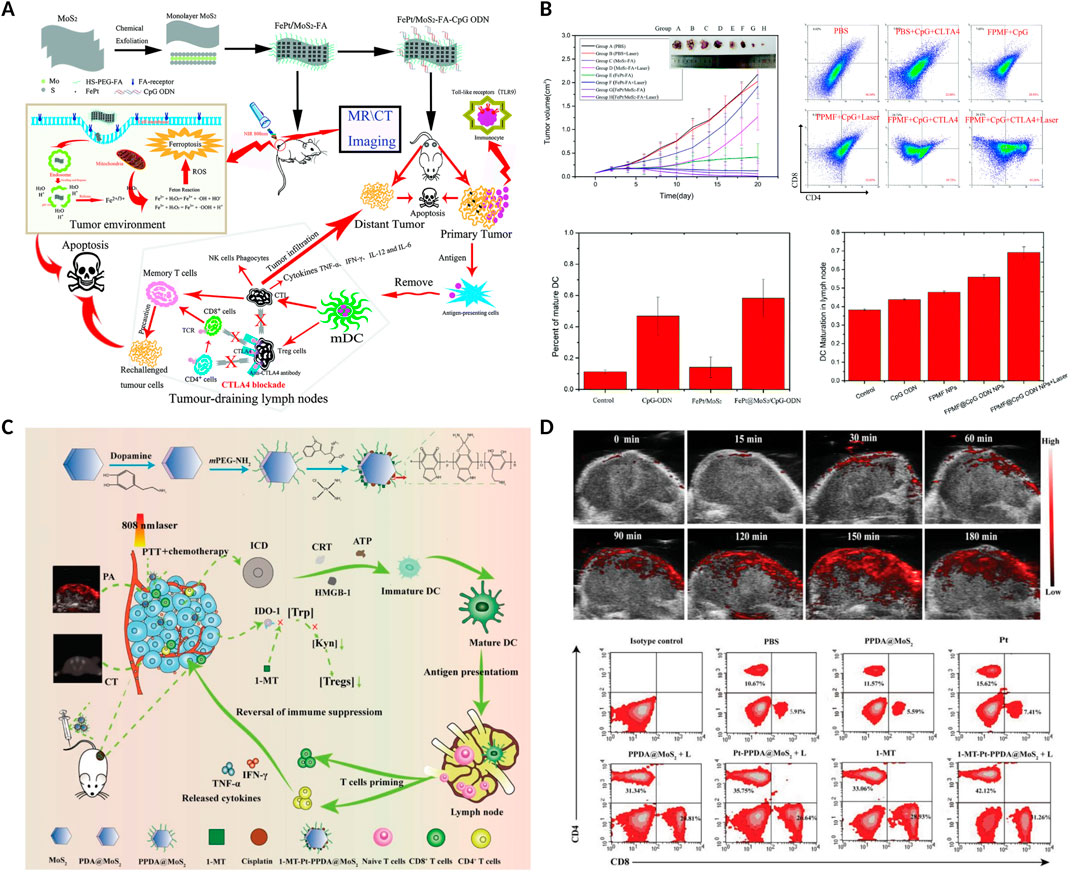
Figure 8. MoS2-based nanomaterials combined with PTT and anti-CTLA4 or 1-methyl-tryptophan (1-MT) enhanced the anticancer ability. (A) Schematic illustration of the FPMF@CpG ODN nanocomposites combined with chemotherapy, 808 nm laser irradiation and anti-CTLA4 in vivo. (B) The volume of tumors, the percentage of CD4+ and CD8+ T cells in tumor, and the percentage of maturation of DCs in lymph nodes after different treatments. Reproduced with permission from Ref. (Zhang D. et al., 2019) Copyright 2019, Royal Society of Chemistry. (C) Schematic illustration of the 1-MT-Pt-PPDA@MoS2 combined with 808 nm laser irradiation and 1-MT in vivo. (D) PA images of tumors at different time points after the 1-MT-Pt-PPDA@MoS2 complexes injection, and flow cytometric analyses of the CD4+ and CD8+ T cells in tumor. Reproduced with permission from Ref (Hu et al., 2021). Copyright The Authors. Advanced Science published by Wiley-VCH GmbH.
WSe2, an excellent member of the p-type TMD semiconductors and having sizable bandgap, has been widely used in building CMOS circuits (Xue et al., 2024). Furtherly, WSe2-based nanomaterials have exhibited high biosafety than graphene-like nanomaterials, showing enormous potential for biomedical applications (Altalbawy et al., 2025). Dong et al. designed WO2.9-WSe2-PEG nanoparticles, semiconductor heterojunction structure, to realize a synergistic RT/PTT/CBT for enhanced antimetastatic and anticancer effect (Dong et al., 2020). As shown in Figure 9A, the WO2.9-WSe2-PEG nanoparticles not only showed excellent ROS overproduction in highly expressed H2O2 TME under X-ray irradiation, but also could enhance RT outcome under the 808 nm laser irradiation via inducing hyperthermia. More importantly, the CD8+ T and CD4+ T cells in distant tumors were significantly activated in distant tumor when WO2.9-WSe2-PEG nanoparticles combined with RT/PTT and anti-PD-L1 antibody, indicating powerful immunological memory-killing and efficiently antimetastatic and anticancer effect (Figure 9B).
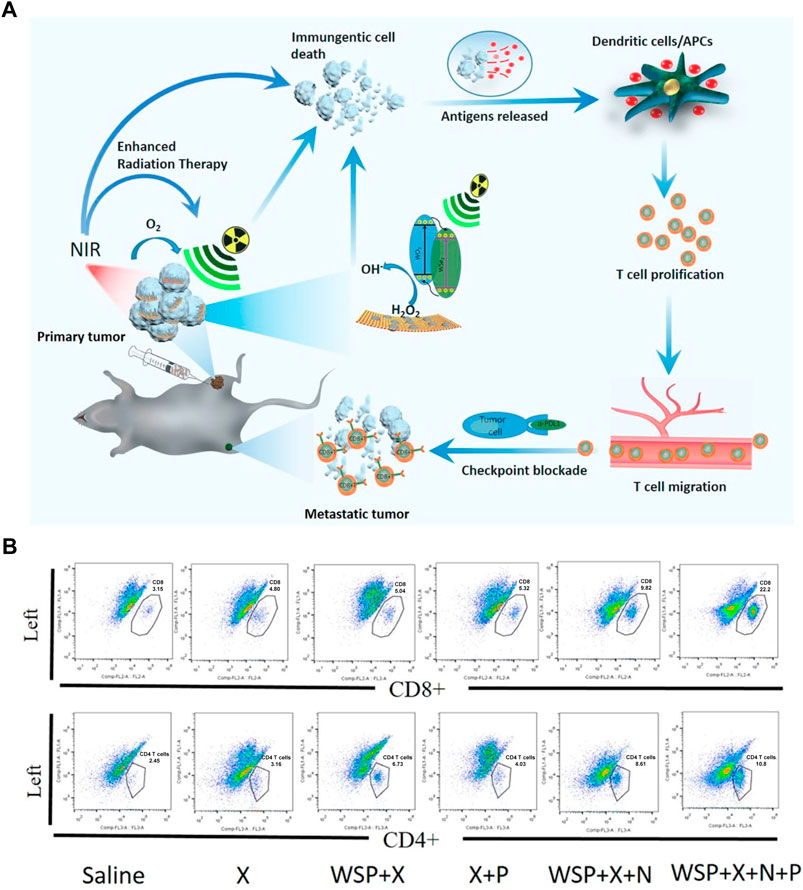
Figure 9. WSe2-based nanomaterials combined with Radiotherapy (RT), PTT and anti-PD-L1 enhanced the anticancer ability. (A) Schematic illustration of the WO2.9-WSe2-PEG nanoparticles combined with RT, 808 nm laser irradiation and anti-PD-L1 in vivo. (B) Flow cytometric analysis of CD8+ T and CD4+ T cells in distant tumors at the end of treatment. Reproduced with permission from Ref (Dong et al., 2020). Copyright 2020, American Chemical Society.
These results clearly illustrate that, due to their excellent physical and chemical properties, MoSe2/MoS2/WSe2-based nanomaterials showed high capacity to activate the CD8+ T and CD4+ T cells, thereby achieving an effective antitumor effect when combining PTT with ICT. However, the mechanisms underlying the activation of immune responses and synergistic effects of PTT in antitumor treatments remain to be elucidated.
Evaluating the superior performance of a photothermal agent usually focuses on its photothermal stability and photothermal conversion efficiency. Cancer cells release heat shock proteins (HSP) under heat stress, and the expression of HSP facilitates the repair of cells that have been damaged by heat, contributing to the development of heat resistance in tumor cells (Jin et al., 2018). Consequently, the aforementioned property of heat resistance in tumor cells compromises the efficacy of thermal ablation at relatively low temperatures. (Toraya-Brown and Fiering, 2014; Tang X et al., 2018). In addition, an appropriate increase in temperature can increase the permeability of the tumor vasculature, thereby promoting immune cells transport to the tumor and changing the visibility of the tumor to immune cells. Therefore, the heat dose (a function of temperature and time of exposure to that temperature) has an important impact on obtaining the desired level of immune stimulation (Nomura et al., 2020). However, the exact amount of heat required to stimulate the immune system is still being explored, while small changes in heat dose may lead to gaps in the efficacy of immune stimulation (Moy and Tunnell, 2017).
Sweeney et al. explored the optimal temperature window for PTT-induced ICD with an animal model of neuroblastoma and demonstrated that too high and too low heat doses are not more favorable for ICD activation (Figure 10A) (Sweeney et al., 2018). Prussian blue nano-particles (PBNPs) was used as the photothermal agent, and three different heat dose groups were set up (low, <40°C; medium, <60°C and high, ≈90°C). Although higher PTT was more effective in tumor inhibition suggested by slower tumor growth and highest survival, thermal dose (3.3–5.6, log (CEM43)) initiated the innate immune responses against tumor challenge (Figures 10B, C). In addition, Sekhri et al., found that thermal doses >5 log (∑CEM43) could efficient induced ICD in SH-SY5Y cells, and thermal doses≥10 log (∑CEM43) in LAN-1 cells, which was consistent with the result that compared with LAN-1 cells, at equivalent thermal doses, cytotoxicity T cells exhibited significantly higher cytotoxicity toward SH-SY5Y cells (Figures 10D–F) (Sekhri et al., 2022).
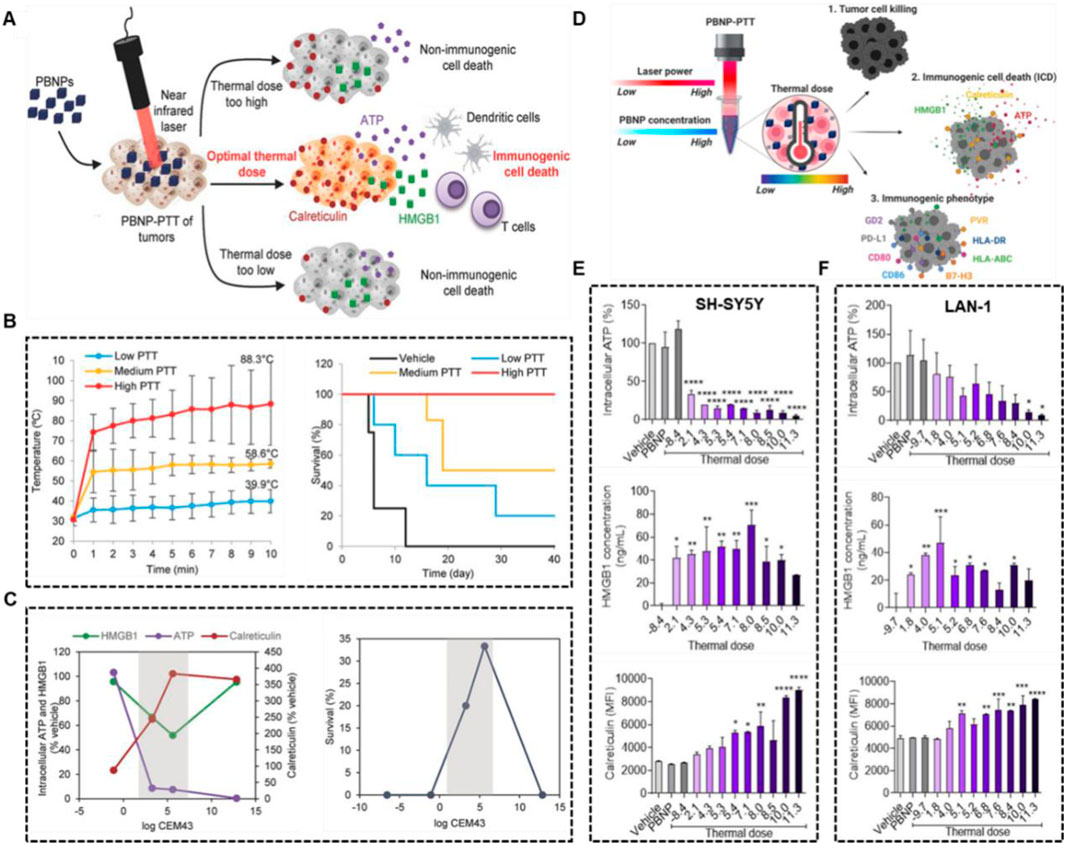
Figure 10. Optimal thermal window of ICD generated by PBNP-based PTT. (A) Schematic illustration of middle thermal dose increasing the ICD. (B) The tumor temperatures and survival of Neuro2a tumor-bearing mice treated with low, medium and high thermal dose PBNP-PTT. (C) Thermal dose [3.3–5.6, log (CEM43)] improved long-term survival of Neuro2a tumor-bearing mice. Reproduced with permission from Ref (Sweeney et al., 2018). Copyright 2018 WILEY-VCH Verlag GmbH and Co. KGaA, Weinheim. (D) Schematic illustration of middle thermal dose, determined by laser power and PBNP concentration, enhanced tumor cell killing and ICD. PBNP-PTT generates a thermal dose window of ICD in SH-SY5Y (E) and LAN-1 (F) cell. Reproduced with permission from Ref (Sekhri et al., 2022). Copyright 2022 by the authors.
It is well established that the size of nanoparticles influences their accumulation and retention time in vivo, as well as their diffusion within tumor tissues. Studies indicate that nanoparticles smaller than 5 nm are quickly cleared by the kidneys, while those larger than 100 nm may be removed by the mononuclear phagocytic cell system (Blanco et al., 2015). The size of nanomaterials used in combination PTT and ICT can influence the immune response, including cellular uptake of nanomaterials, the maturation of antigen-presenting cells (APCs), and the balance between Th2 and Th1 immune responses. Nanoparticles that are similar in size to pathogens are more readily identified and effectively internalized by APCs to trigger immune responses. Dendritic cells (DCs) preferentially internalize particles in the range of 20–200 nm, while macrophages tend to internalize larger particles (0.5–5 μm) (Zhao et al., 2014). Additionally, the photothermal conversion efficiency of nanomaterials must be considered. For instance, in the case of plasmonic nanoparticles with LSPR, the absorption, scattering, and extinction coefficients are all size- and shape-dependent (Jain et al., 2006; Kim et al., 2019). The optimal size of nanoparticles for maximizing the efficacy of PTT and ICT varies and depends on specific conditions.
The above studies suggest that different metal-based photothermal agents and their sizes may have the most suitable thermal doses for efficiently addressing the issue of cancer cells escaping immune recognition when combined PTT with and ICT.
This review outlines recent developments in metal-based photothermal therapy in conjunction with immune checkpoint therapy. Noble metal-based and 2D TMDCs-based photothermal agents showed high capacity to activate the CD8+ T and CD4+ T cells to realize complete tumor inhibition and inhibit cancer cells metastasis when combined PTT with ICT. Nevertheless, metal-based photothermal therapy encounters several challenges that hinder its potential synergistic application with ICT and clinical translation, which are as follows: 1) Most metal-based photothermal agents were low photothermal conversion efficiency and biocompatibility; 2) Tumors in situ were little used to evaluate synergistic effects in vivo; 3) Noble metal-based photothermal agents and ICBs are expensive; 4) The tumor thermotolerance triggered by photothermal therapy has been established; 5) Even with NIR-II light, the irradiation sources used for most metal-based photothermal agents often struggle to penetrate the deep-seated solid tumors; 6) Current research has been limited to preclinical studies in mice and has yet to be corroborated by large-scale clinical trials (Sun et al., 2024).
As mentioned above, although the combination of PTT and ICT effectively addresses the limitations of monotherapy and brings breakthrough in cancer treatment, the development of a photothermal agent with low toxicity, high photothermal effect and cost-effective remains a bottleneck in its clinical translation. Moreover, the mechanisms underlying the activation of immune responses and synergistic effects of PTT in antitumor treatments remain to be elucidated.
Overall, the development of safe and efficient metal-based photothermal agents for enhanced synergistic ICBs therapy in cancer treatment presents both challenges and opportunities.
BX: Data curation, Formal Analysis, Investigation, Methodology, Project administration, Software, Writing–original draft, Writing–review and editing. ZX: Formal Analysis, Writing–original draft. JL: Methodology, Writing–original draft. YP: Writing–review and editing. TC: Conceptualization, Investigation, Writing–original draft, Writing–review and editing.
The author(s) declare that financial support was received for the research, authorship, and/or publication of this article. This work was supported by the National Key R&D Program of China (2023YFC3402800), the National Science Fund for Distinguished Yong Scholars (82225025), the National Natural Science Foundation of China (32171296).
The authors declare that the research was conducted in the absence of any commercial or financial relationships that could be construed as a potential conflict of interest.
The author(s) declare that no Generative AI was used in the creation of this manuscript.
All claims expressed in this article are solely those of the authors and do not necessarily represent those of their affiliated organizations, or those of the publisher, the editors and the reviewers. Any product that may be evaluated in this article, or claim that may be made by its manufacturer, is not guaranteed or endorsed by the publisher.
Altalbawy, F. M., Hussein, U. a.-R., Baldaniya, L., Rekha, M., Guntaj, J., Gupta, A., et al. (2025). -DFT study of the adsorption of temozolamide anticancer drugs on the TM-adsorbed WSe2 nanocarriers: applications to drug delivery systems. Comput. Theor. Chem. 1243, 114974. doi:10.1016/j.comptc.2024.114974
Ban, Q., Bai, T., Duan, X., and Kong, J. (2017). Noninvasive photothermal cancer therapy nanoplatforms via integrating nanomaterials and functional polymers. Biomater. Sci. 5, 190–210. doi:10.1039/C6BM00600K
Blanco, E., Shen, H., and Ferrari, M. (2015). Principles of nanoparticle design for overcoming biological barriers to drug delivery. Nat. Biotechnol. 33, 941–951. doi:10.1038/nbt.3330
Boca, S. C., Potara, M., Gabudean, A.-M., Juhem, A., Baldeck, P. L., and Astilean, S. (2011). Chitosan-coated triangular silver nanoparticles as a novel class of biocompatible, highly effective photothermal transducers for in vitro cancer cell therapy. Cancer Lett. 311, 131–140. doi:10.1016/j.canlet.2011.06.022
Bray, F., Laversanne, M., Sung, H., Ferlay, J., Siegel, R. L., Soerjomataram, I., et al. (2024). Global cancer statistics 2022: GLOBOCAN estimates of incidence and mortality worldwide for 36 cancers in 185 countries. CA Cancer J. Clin. 74, 229–263. doi:10.3322/caac.21834
Chang, M., Wang, M., Wang, M., Shu, M., Ding, B., Li, C., et al. (2019). A multifunctional cascade bioreactor based on hollow-structured Cu2MoS4 for synergetic cancer chemo-dynamic therapy/starvation therapy/phototherapy/immunotherapy with remarkably enhanced efficacy. Adv. Mat. 31, 1905271. doi:10.1002/adma.201905271
Chen, Z., Wei, X., Zheng, Y., Zhang, Z., Gu, W., Liao, W., et al. (2023). Targeted co-delivery of curcumin and erlotinib by MoS2 nanosheets for the combination of synergetic chemotherapy and photothermal therapy of lung cancer. J. Nanobiotechnol. 21, 333. doi:10.1186/s12951-023-02099-4
Chu, K. F., and Dupuy, D. E. (2014). Thermal ablation of tumours: biological mechanisms and advances in therapy. Nat. Rev. Cancer. 14, 199–208. doi:10.1038/nrc3672
Copier, J., and Dalgleish, A. (2006). Overview of tumor cell-based vaccines. Int. Rev. Immunol. 25, 297–319. doi:10.1080/08830180600992472
Debela, D. T., Muzazu, S. G., Heraro, K. D., Ndalama, M. T., Mesele, B. W., Haile, D. C., et al. (2021). New approaches and procedures for cancer treatment: current perspectives. SAGE Open Med. 9, 20503121211034366. doi:10.1177/20503121211034366
Deng, X., Shao, Z., and Zhao, Y. (2021). Solutions to the drawbacks of photothermal and photodynamic cancer therapy. Adv. Sci. 8, 2002504. doi:10.1002/advs.202002504
Depciuch, J., Stec, M., Klebowski, B., Maximenko, A., Drzymała, E., Baran, J., et al. (2020). Size effect of platinum nanoparticles in simulated anticancer photothermal therapy. Photodiagn. Photodyn. Ther. 29, 101594. doi:10.1016/j.pdpdt.2019.101594
Ding, J., Gao, B., Chen, Z., and Mei, X. (2021). An NIR-triggered Au nanocage used for photo-thermo therapy of chronic wound in diabetic rats through bacterial membrane destruction and skin cell mitochondrial protection. Front. Pharmacol. 12, 779944. doi:10.3389/fphar.2021.779944
Dong, X., Cheng, R., Zhu, S., Liu, H., Zhou, R., Zhang, C., et al. (2020). A heterojunction structured WO2.9-WSe2 nanoradiosensitizer increases local tumor ablation and checkpoint blockade immunotherapy upon low radiation dose. ACS Nano 14, 5400–5416. doi:10.1021/acsnano.9b08962
Doroshow, D. B., Bhalla, S., Beasley, M. B., Sholl, L. M., Kerr, K. M., Gnjatic, S., et al. (2021). PD-L1 as a biomarker of response to immune-checkpoint inhibitors. Nat. Rev. Clin. Oncol. 18, 345–362. doi:10.1038/s41571-021-00473-5
Feng, W., Chen, L., Qin, M., Zhou, X., Zhang, Q., Miao, Y., et al. (2015). Flower-like PEGylated MoS2 nanoflakes for near-infrared photothermal cancer therapy. Sci. Rep. 5, 17422. doi:10.1038/srep17422
Filin, I. Y., Solovyeva, V. V., Kitaeva, K. V., Rutland, C. S., and Rizvanov, A. A. (2020). Current trends in cancer immunotherapy. Biomedicines 8, 621. doi:10.3390/biomedicines8120621
Gajewski, T. F., Schreiber, H., and Fu, Y.-X. (2013). Innate and adaptive immune cells in the tumor microenvironment. Nat. Immunol. 14, 1014–1022. doi:10.1038/ni.2703
Gao, F., Miao, Y., Ma, H., Zhang, T., Fan, H., and Zhao, L. (2021). Boosting the photothermal performance of vacancy-rich MoSe2-x nanoflowers for photoacoustic imaging guided tumor chemo-photothermal therapy. Nanoscale 13, 14960–14972. doi:10.1039/D1NR03306A
Gao, P., Wang, H., and Cheng, Y. (2022). Strategies for efficient photothermal therapy at mild temperatures: progresses and challenges. Chin. Chem. Lett. 33, 575–586. doi:10.1016/j.cclet.2021.08.023
Gong, L., Yan, L., Zhou, R., Xie, J., Wu, W., and Gu, Z. (2017). Two-dimensional transition metal dichalcogenide nanomaterials for combination cancer therapy. J. Mat. Chem. B 5, 1873–1895. doi:10.1039/C7TB00195A
Gui, H., Feng, Y., Qiang, L., Sun, T., and Liu, L. (2021). Core/shell structural ultra-small gold and amyloid peptide nanocomposites with effective bacterial surface adherence and enhanced antibacterial photothermal ablation. Smart Mat. Med. 2, 46–55. doi:10.1016/j.smaim.2020.12.001
Guo, R., Wang, S., Zhao, L., Zong, Q., Li, T., Ling, G., et al. (2022). Engineered nanomaterials for synergistic photo-immunotherapy. Biomaterials 282, 121425. doi:10.1016/j.biomaterials.2022.121425
He, G., Shuai, Y., Hai, Y., Yang, T., Pan, X., Liu, Y., et al. (2022). Integration of gold nanodendrites and immune checkpoint blockers to achieve highly efficient photothermal immunotherapy for eradicating primary and distant metastatic osteosarcoma. Mat. Today Nano 20, 100268. doi:10.1016/j.mtnano.2022.100268
He, L., Chen, Q., Lu, Q., Yang, M., Xie, B., Chen, T., et al. (2024). Autophagy-inducing MoO3-x nanowires boost photothermal-triggered cancer immunotherapy. Angew. Chem. 63, e202404822. doi:10.1002/anie.202404822
He, L., Nie, T., Xia, X., Liu, T., Huang, Y., Wang, X., et al. (2019). Designing bioinspired 2D MoSe2 nanosheet for efficient photothermal-triggered cancer immunotherapy with reprogramming tumor-associated macrophages. Adv. Funct. Mat. 29, 1901240. doi:10.1002/adfm.201901240
He, X., and Xu, C. (2020). Immune checkpoint signaling and cancer immunotherapy. Cell Res. 30, 660–669. doi:10.1038/s41422-020-0343-4
Hernández, Y., and Galarreta, B. C. (2019). Noble metal-based plasmonic nanoparticles for SERS imaging and photothermal therapy. Nanomater. Magnetic Opt. Hyperth. Appl., 83–109. doi:10.1016/B978-0-12-813928-8.00004-1
Hu, W., Xiao, T., Li, D., Fan, Y., Xing, L., Wang, X., et al. (2021). Intelligent molybdenum disulfide complexes as a platform for cooperative imaging-guided tri-mode chemo-photothermo-immunotherapy. Adv. Sci. 8, 2100165. doi:10.1002/advs.202100165
Huang, X., Lu, Y., Guo, M., Du, S., and Han, N. (2021). Recent strategies for nano-based PTT combined with immunotherapy: from a biomaterial point of view. Theranostics 11, 7546–7569. doi:10.7150/thno.56482
Huang, Z., Gao, L., Kong, L., Zhang, H.-H., Yang, J.-X., and Li, L. (2019). In vivo two-photon imaging/excited photothermal therapy strategy of a silver-nanohybrid. J. Mat. Chem. B 7, 7377–7386. doi:10.1039/C9TB01769K
Huang H, H., Zou, B., Zhu, S., Zhang, X., Huang, J., Wang, J., et al. (2024). PD-L1-driven efficient enrichment and elimination of circulating cancer cells by magnetic MoSe2 nanosheet. Nano Res. 17, 4350–4358. doi:10.1007/s12274-023-6342-2
Huang Z, Z., Song, J., Huang, S., Wang, S., Shen, C., Song, S., et al. (2024). Phase and defect engineering of MoSe2 nanosheets for enhanced NIR-II photothermal immunotherapy. Nano Lett. 24, 7764–7773. doi:10.1021/acs.nanolett.4c01879
Jahangiri-Manesh, A., Mousazadeh, M., Taji, S., Bahmani, A., Zarepour, A., Zarrabi, A., et al. (2022). Gold nanorods for drug and gene delivery: an overview of recent advancements. Pharm 14, 664. doi:10.3390/pharmaceutics14030664
Jain, P. K., Lee, K. S., El-Sayed, I. H., and El-Sayed, M. A. (2006). Calculated absorption and scattering properties of gold nanoparticles of different size, shape, and composition: applications in biological imaging and biomedicine. J. Phys. Chem. B 110, 7238–7248. doi:10.1021/jp057170o
Jia, X., Bai, J., Ma, Z., and Jiang, X. (2017). BSA-exfoliated WSe2 nanosheets as a photoregulated carrier for synergistic photodynamic/photothermal therapy. J. Mat. Chem. B 5, 269–278. doi:10.1039/C6TB02525K
Jiang, W., Zhang, Z., Ye, M., Pan, S., Huang, G., Chen, T., et al. (2022). Morphology-directed radiosensitization of MoSe2 nanoplatforms for promoting cervical cancer radiotherapy. Nano Today 46, 101598. doi:10.1016/j.nantod.2022.101598
Jiang, X., Liu, G., Li, Y., and Pan, Y. (2021). Immune checkpoint: the novel target for antitumor therapy. Genes Dis. 8, 25–37. doi:10.1016/j.gendis.2019.12.004
Jin, L., Shen, S., Huang, Y., Li, D., and Yang, X. (2021). Corn-like Au/Ag nanorod-mediated NIR-II photothermal/photodynamic therapy potentiates immune checkpoint antibody efficacy by reprogramming the cold tumor microenvironment. Biomaterials 268, 120582. doi:10.1016/j.biomaterials.2020.120582
Jin, Y., Liang, L., Sun, X., Yu, G., Chen, S., Shi, S., et al. (2018). Deoxyribozyme-nanosponges for improved photothermal therapy by overcoming thermoresistance. NPG Asia Mater 10, 373–384. doi:10.1038/s41427-018-0040-7
Kim, J., Kim, H., and Kim, W. J. (2016). Single-layered MoS2-PEI-PEG nanocomposite-mediated gene delivery controlled by photo and redox stimuli. Small 12, 1184–1192. doi:10.1002/smll.201501655
Kim, M., Lee, J. H., and Nam, J. M. (2019). Plasmonic photothermal nanoparticles for biomedical applications. Adv. Sci. 6, 1900471. doi:10.1002/advs.201900471
Kong, C., and Chen, X. (2022). Combined photodynamic and photothermal therapy and immunotherapy for cancer treatment: a review. Int. J. Nanomed. 17, 6427–6446. doi:10.2147/IJN.S388996
Kong, N., Ding, L., Zeng, X., Wang, J., Li, W., Shi, S., et al. (2019). Comprehensive insights into intracellular fate of WS2 nanosheets for enhanced photothermal therapeutic outcomes via exocytosis inhibition. Nanophotonics 8, 2331–2346. doi:10.1515/nanoph-2019-0343
Lakkakula, J., Satam, Y., Alexander, S., Bose, R., and Uddin, I. (2024). Palladium nanoparticles as a platform for cancer diagnosis and treatment. BioNanoScience 14, 4342–4359. doi:10.1007/s12668-024-01603-w
Li, B., Xu, D., Chen, Y., Li, W., Liu, H., Ansari, A. A., et al. (2024). Polyethylenimine-Coated Pt–Mn nanostructures for synergistic photodynamic/photothermal/chemodynamic tumor therapy. ACS Appl. Nano Mat. 7, 9428–9440. doi:10.1021/acsanm.4c00890
Li, X., Lovell, J. F., Yoon, J., and Chen, X. (2020). Clinical development and potential of photothermal and photodynamic therapies for cancer. Nat. Rev. Clin. Oncol. 17, 657–674. doi:10.1038/s41571-020-0410-2
Li, Y., Cui, J., Li, C., Deng, C., Deng, G., Zhang, H., et al. (2023). Biomaterial-assisted photoimmunotherapy for synergistic suppression of cancer progression. Chin. Chem. Lett. 34, 108180. doi:10.1016/j.cclet.2023.108180
Li L, L., Wen, J., Zhang, X., Fu, S., Chen, Z., Huang, K., et al. (2024). A near-infrared naphthalocyanine photosensitizer with superior light absorption and renal clearance for type-I photodynamic and photothermal combination therapy. Chin. Chem. Lett. 110290, 110290. doi:10.1016/j.cclet.2024.110290
Lin, C., Hao, H., Mei, L., and Wu, M. (2020). Metal-free two-dimensional nanomaterial-mediated photothermal tumor therapy. Smart Mat. Med. 1, 150–167. doi:10.1016/j.smaim.2020.09.001
Lin, Z., Nie, F., Zhang, Z., Gong, X., Zhang, J., Xu, J., et al. (2024). Construction of natural polysaccharide-based pH-responsive gold nanorods for combined photothermal therapy and immunotherapy. ACS Appl. Nano Mat. 7, 10466–10478. doi:10.1021/acsanm.4c00856
Li S, S., Li, Z., Hao, Q., Wang, S., Yang, Y., Xu, J., et al. (2024). Ultrastable graphene isolated AuAg nanoalloy for SERS biosensing and photothermal therapy of bacterial infection. Chin. Chem. Lett. 35, 108636. doi:10.1016/j.cclet.2023.108636
Liu, G., Zhu, J., Guo, H., Sun, A., Chen, P., Xi, L., et al. (2019). Mo2C-derived polyoxometalate for NIR-II photoacoustic imaging-guided chemodynamic/photothermal synergistic therapy. Angew. Chem. Int. Ed. 58, 18641–18646. doi:10.1002/anie.201910815
Liu, J., Chen, Z., Li, Y., Zhao, W., Wu, J., and Zhang, Z. (2021). PD-1/PD-L1 checkpoint inhibitors in tumor immunotherapy. Front. Pharmacol. 12, 731798. doi:10.3389/fphar.2021.731798
Liu, T., Wang, C., Cui, W., Gong, H., Liang, C., Shi, X., et al. (2014). Combined photothermal and photodynamic therapy delivered by PEGylated MoS2 nanosheets. Nanoscale 6, 11219–11225. doi:10.1039/c4nr03753g
Liu, Y., Ding, M., Guo, K., Wang, Z., Zhang, C., and Shubhra, Q. T. (2022). Systemic Co-delivery of drugs by a pH-and photosensitive smart nanocarrier to treat cancer by chemo-photothermal-starvation combination therapy. Smart Mat. Med. 3, 390–403. doi:10.1016/j.smaim.2022.05.003
Liu, Y., Wei, C., Lin, A., Pan, J., Chen, X., Zhu, X., et al. (2020). Responsive functionalized MoSe2 nanosystem for highly efficient synergistic therapy of breast cancer. Colloids Surf. B Biointerfaces 189, 110820. doi:10.1016/j.colsurfb.2020.110820
Liu, Z., Chan, L., Ye, X., Bai, Y., and Chen, T. (2018). BSA-based Cu2Se nanoparticles with multistimuli-responsive drug vehicles for synergistic chemo-photothermal therapy. Colloids Surf. B Biointerfaces 172, 298–307. doi:10.1016/j.colsurfb.2018.07.041
Liu B, B., Zhou, H., Tan, L., Siu, K. T. H., and Guan, X.-Y. (2024). Exploring treatment options in cancer: tumor treatment strategies. Signal Transduct. Target. Ther. 9, 175. doi:10.1038/s41392-024-01856-7
Liu Y, Y., Yang, F., Li, Z., Wang, T., Mu, Y., Fan, Y., et al. (2024). Concurrent immune checkpoint blockade for enhanced cancer immunotherapy utilizing engineered hybrid nanovesicles. Front. Pharmacol. 15, 1487940. doi:10.3389/fphar.2024.1487940
Long, Y., Wu, X., Li, Z., Fan, J., Hu, X., and Liu, B. (2020). PEGylated WS2 nanodrug system with erythrocyte membrane coating for chemo/photothermal therapy of cervical cancer. Biomater. Sci. 8, 5088–5105. doi:10.1039/D0BM00972E
Ma, G., Liu, Z., Zhu, C., Chen, H., Kwok, R. T., Zhang, P., et al. (2022). H2O2-Responsive NIR-II AIE nanobomb for carbon monoxide boosting low-temperature photothermal therapy. Angew. Chem. Int. Ed. 61, e202207213. doi:10.1002/anie.202207213
Manikandan, M., Hasan, N., and Wu, H.-F. (2013). Platinum nanoparticles for the photothermal treatment of Neuro 2A cancer cells. Biomaterials 34, 5833–5842. doi:10.1016/j.biomaterials.2013.03.077
Marin-Acevedo, J. A., Dholaria, B., Soyano, A. E., Knutson, K. L., Chumsri, S., and Lou, Y. (2018). Next generation of immune checkpoint therapy in cancer: new developments and challenges. J. Hematol. Oncol. 11, 39–20. doi:10.1186/s13045-018-0582-8
Matias, M., Pinho, J. O., Penetra, M. J., Campos, G., Reis, C. P., and Gaspar, M. M. (2021). The challenging melanoma landscape: from early drug discovery to clinical approval. Cells 10, 3088. doi:10.3390/cells10113088
Mondal, A., and De, M. (2024). Exfoliation, functionalization and antibacterial activity of transition metal dichalcogenides. Tungsten 6, 1–16. doi:10.1007/s42864-022-00196-9
Moy, A. J., and Tunnell, J. W. (2017). Combinatorial immunotherapy and nanoparticle mediated hyperthermia. Adv. Drug Deliv. Rev. 114, 175–183. doi:10.1016/j.addr.2017.06.008
Nam, J., Son, S., Ochyl, L. J., Kuai, R., Schwendeman, A., and Moon, J. J. (2018). Chemo-photothermal therapy combination elicits anti-tumor immunity against advanced metastatic cancer. Nat. Commun. 9, 1074. doi:10.1038/s41467-018-03473-9
Nomura, S., Morimoto, Y., Tsujimoto, H., Arake, M., Harada, M., Saitoh, D., et al. (2020). Highly reliable, targeted photothermal cancer therapy combined with thermal dosimetry using a near-infrared absorbent. Sci. Rep. 10, 9765. doi:10.1038/s41598-020-66646-x
Pan, H., Li, S., Kan, J.-L., Gong, L., Lin, C., Liu, W., et al. (2019). A cruciform phthalocyanine pentad-based NIR-II photothermal agent for highly efficient tumor ablation. Chem. Sci. 10, 8246–8252. doi:10.1039/C9SC02674F
Pan, W., Liu, C., Li, Y., Yang, Y., Li, W., Feng, C., et al. (2022). Ultrathin tellurium nanosheets for simultaneous cancer thermo-chemotherapy. Bioact. Mat. 13, 96–104. doi:10.1016/j.bioactmat.2021.11.010
Qi, F., and Liu, R. (2019). Tumor-targeted and biocompatible MoSe2 nanodots@albumin nanospheres as a dual-modality therapy agent for synergistic photothermal radiotherapy. Nanoscale Res. Lett. 14, 67–11. doi:10.1186/s11671-019-2896-z
Sekhri, P., Ledezma, D. K., Shukla, A., Sweeney, E. E., and Fernandes, R. (2022). The thermal dose of photothermal therapy generates differential immunogenicity in human neuroblastoma cells. Cancers 14, 1447. doi:10.3390/cancers14061447
Shao, J., Zhang, J., Jiang, C., Lin, J., and Huang, P. (2020). Biodegradable titanium nitride MXene quantum dots for cancer phototheranostics in NIR-I/II biowindows. Chem. Eng. J. 400, 126009. doi:10.1016/j.cej.2020.126009
Shao, K., Singha, S., Clemente-Casares, X., Tsai, S., Yang, Y., and Santamaria, P. (2015). Nanoparticle-based immunotherapy for cancer. ACS Nano 9, 16–30. doi:10.1021/nn5062029
Shuai, Y., Bao, Q., Yue, H., Wang, J., Yang, T., Wan, Q., et al. (2023). Tumor microenvironment-responsive gold nanodendrites for nanoprobe-based single-cell Raman imaging and tumor-targeted chemo-photothermal therapy. Smart Mat. Med. 4, 680–689. doi:10.1016/j.smaim.2023.06.002
Singh, P., Haloi, P., Singh, K., Roy, S., Sarkar, A., Choudhary, R., et al. (2023). Palladium nanocapsules for photothermal therapy in the near-infrared II biological window. ACS Appl. Mat. Interfaces 15, 39081–39098. doi:10.1021/acsami.3c06186
Song, H., Su, Q., Huang, P., Zhang, C., and Wang, W. (2021). Self-assembling, self-adjuvanting and fully synthetic peptide nanovaccine for cancer immunotherapy. Smart Mat. Med. 2, 237–249. doi:10.1016/j.smaim.2021.07.007
Sun, X.-R., Yuan, H.-M., Zhang, G.-D., Wang, C., Sun, S.-J., and Shi, P.-F. (2024). A Mn-porphyrinic metal–organic framework immobilizing glucose oxidase for combined photodynamic/chemodynamic/starvation therapy. Tungsten 14, 183–194. doi:10.1007/s42864-024-00283-z
Sun S, S., Song, Y., Chen, J., Huo, M., Chen, Y., and Sun, L. (2021). NIR-I and NIR-II irradiation tumor ablation using NbS2 nanosheets as the photothermal agent. Nanoscale 13, 18300–18310. doi:10.1039/D1NR05449J
Sun Y, Y., Jiang, L., Wen, T., Guo, X., Shao, X., Qu, H., et al. (2021). Trends in the research into immune checkpoint blockade by anti-PD1/PDL1 antibodies in cancer immunotherapy: a bibliometric study. Front. Pharmacol. 12, 670900. doi:10.3389/fphar.2021.670900
Sweeney, E. E., Cano-Mejia, J., and Fernandes, R. (2018). Photothermal therapy generates a thermal window of immunogenic cell death in neuroblastoma. Small 14, 1800678. doi:10.1002/smll.201800678
Tai, Y.-W., Chiu, Y.-C., Wu, P.-T., Yu, J., Chin, Y.-C., Wu, S.-P., et al. (2018). Degradable NIR-PTT nanoagents with a potential Cu@Cu2O@Polymer structure. ACS Appl. Mat. Interfaces 10, 5161–5174. doi:10.1021/acsami.7b15109
Tan, S., Li, D., and Zhu, X. (2020). Cancer immunotherapy: pros, cons and beyond. Biomed. Pharmacother. 124, 109821. doi:10.1016/j.biopha.2020.109821
Tang X, X., Tan, L., Shi, K., Peng, J., Xiao, Y., Li, W., et al. (2018). Gold nanorods together with HSP inhibitor-VER-155008 micelles for colon cancer mild-temperature photothermal therapy. Acta Pharm. Sin. B 8, 587–601. doi:10.1016/j.apsb.2018.05.011
Tang Z, Z., Zhao, P., Ni, D., Liu, Y., Zhang, M., Wang, H., et al. (2018). Pyroelectric nanoplatform for NIR-II-triggered photothermal therapy with simultaneous pyroelectric dynamic therapy. Mat. Horiz. 5, 946–952. doi:10.1039/C8MH00627J
Toraya-Brown, S., and Fiering, S. (2014). Local tumour hyperthermia as immunotherapy for metastatic cancer. Int. J. Hyperth. 30, 531–539. doi:10.3109/02656736.2014.968640
Wang, J., Chang, Y., Luo, H., Jiang, W., Xu, L., Chen, T., et al. (2020). Designing immunogenic nanotherapeutics for photothermal-triggered immunotherapy involving reprogramming immunosuppression and activating systemic antitumor responses. Biomaterials 255, 120153. doi:10.1016/j.biomaterials.2020.120153
Wang, J., Tan, X., Pang, X., Liu, L., Tan, F., and Li, N. (2016). MoS2 quantum dot@ polyaniline inorganic-organic nanohybrids for in vivo dual-modal imaging guided synergistic photothermal/radiation therapy. ACS Appl. Mat. Interfaces 8, 24331–24338. doi:10.1021/acsami.6b08391
Wang, M., Chang, M., Zheng, P., Sun, Q., Wang, G., Lin, J., et al. (2022). A noble AuPtAg-GOx nanozyme for synergistic tumor immunotherapy induced by starvation therapy-augmented mild photothermal therapy. Adv. Sci. 9, 2202332. doi:10.1002/advs.202202332
Wang, X., Wang, C., Cheng, L., Lee, S.-T., and Liu, Z. (2012). Noble metal coated single-walled carbon nanotubes for applications in surface enhanced Raman scattering imaging and photothermal therapy. J. Am. Chem. Soc. 134, 7414–7422. doi:10.1021/ja300140c
Wang, Y., Zhao, J., Chen, Z., Zhang, F., Wang, Q., Guo, W., et al. (2019). Construct of MoSe2/Bi2Se3 nanoheterostructure: multimodal CT/PT imaging-guided PTT/PDT/chemotherapy for cancer treating. Biomaterials 217, 119282. doi:10.1016/j.biomaterials.2019.119282
Wang, Z., Wang, J., Liu, J., Zhang, Y., Zhang, J., Yang, R., et al. (2023). Platinum nanoparticles enhance osteogenic differentiation of human dental follicle stem cells via scavenging ROS. Smart Mat. Med. 4, 621–638. doi:10.1016/j.smaim.2023.06.004
Wang, Z.-Q., Pan, Y.-W., Wu, J., Qi, H.-B., Zhu, S., and Gu, Z.-J. (2024). A bibliometric analysis of molybdenum-based nanomaterials in the biomedical field. Tungsten 6, 17–47. doi:10.1007/s42864-023-00225-1
Wei, J., Li, J., Sun, D., Li, Q., Ma, J., Chen, X., et al. (2018). A novel theranostic nanoplatform based on Pd@Pt-PEG-Ce6 for enhanced photodynamic therapy by modulating tumor hypoxia microenvironment. Adv. Funct. Mat. 28, 1706310. doi:10.1002/adfm.201706310
Wen, C., Guo, X., Gao, C., Zhu, Z., Meng, N., Shen, X.-C., et al. (2022). NIR-II-responsive AuNRs@SiO2-RB@MnO2 nanotheranostic for multimodal imaging-guided CDT/PTT synergistic cancer therapy. J. Mat. Chem. B 10, 4274–4284. doi:10.1039/D1TB02807C
Wen, Y., Chen, X., Zhu, X., Gong, Y., Yuan, G., Qin, X., et al. (2019). Photothermal-chemotherapy integrated nanoparticles with tumor microenvironment response enhanced the induction of immunogenic cell death for colorectal cancer efficient treatment. ACS Appl. Mat. Interfaces 11, 43393–43408. doi:10.1021/acsami.9b17137
Wu, J., Hu, T., Zhao, G., Li, A., and Liang, R. (2022a). Two-dimensional transition metal chalcogenide nanomaterials for cancer diagnosis and treatment. Chin. Chem. Lett. 33, 4437–4448. doi:10.1016/j.cclet.2021.12.080
Wu, J., Wang, S., Liu, S., Liu, F., and Zhou, F. (2022b). Immunoadjuvant nanoparticles as trojan horses for enhanced photo-immunotherapy in the treatment of triple-negative breast cancer. Front. Pharmacol. 13, 883428. doi:10.3389/fphar.2022.883428
Xie, M., Ye, P., Zhao, R., and Yang, M. (2023). Magnetic WS2 nanosheets functionalized by biomimetic lipids with enhanced dispersibility for combined photothermal and chemotherapy therapy. J. Drug Deliv. Sci. Technol. 86, 104744. doi:10.1016/j.jddst.2023.104744
Xiong, W., Cheng, Z., Chen, H., Liang, H., Wang, M., Chen, Y., et al. (2024). Biomimetic tumor cell membrane-encapsulated nanoparticles combine NIR-II photothermal therapy and chemotherapy for enhanced immunotherapy in triple-negative breast cancer. Adv. Funct. Mat. 34, 2410841. doi:10.1002/adfm.202410841
Xue, G., Qin, B., Ma, C., Yin, P., Liu, C., and Liu, K. (2024). Large-area epitaxial growth of transition metal dichalcogenides. Chem. Rev. 124, 9785–9865. doi:10.1021/acs.chemrev.3c00851
Yang, G., Liu, J., Wu, Y., Feng, L., and Liu, Z. (2016). Near-infrared-light responsive nanoscale drug delivery systems for cancer treatment. Coord. Chem. Rev. 320, 100–117. doi:10.1016/j.ccr.2016.04.004
Yang, Q., Peng, J., Shi, K., Xiao, Y., Liu, Q., Han, R., et al. (2019). Rationally designed peptide-conjugated gold/platinum nanosystem with active tumor-targeting for enhancing tumor photothermal-immunotherapy. J. Control. Release 308, 29–43. doi:10.1016/j.jconrel.2019.06.031
Yang, T., Ke, H., Wang, Q., Tang, Y. A., Deng, Y., Yang, H., et al. (2017). Bifunctional tellurium nanodots for photo-induced synergistic cancer therapy. ACS Nano 11, 10012–10024. doi:10.1021/acsnano.7b04230
Yang, Y., Liu, Y., Yang, Q., and Liu, T. (2024). The application of selenium nanoparticles in immunotherapy. Nano Biomed. Eng. 16, 345–356. doi:10.26599/NBE.2024.9290100
Yang F, F., Hu, P., Yang, F., Hua, X.-J., Chen, B., Gao, L., et al. (2024). Photocatalytic applications and modification methods of two-dimensional nanomaterials: a review. Tungsten 6, 77–113. doi:10.1007/s42864-023-00229-x
Yin, X., Fan, T., Zheng, N., Yang, J., Yan, L., He, S., et al. (2023). Palladium nanoparticle based smart hydrogels for NIR light-triggered photothermal/photodynamic therapy and drug release with wound healing capability. Nanoscale Adv. 5, 1729–1739. doi:10.1039/D2NA00897A
Younis, M. R., Wang, C., An, R., Wang, S., Younis, M. A., Li, Z.-Q., et al. (2019). Low power single laser activated synergistic cancer phototherapy using photosensitizer functionalized dual plasmonic photothermal nanoagents. ACS Nano 13, 2544–2557. doi:10.1021/acsnano.8b09552
Yu, S., Xia, G., Yang, N., Yuan, L., Li, J., Wang, Q., et al. (2024). Noble metal nanoparticle-based photothermal therapy: development and application in effective cancer therapy. Int. J. Mol. Sci. 25, 5632. doi:10.3390/ijms25115632
Yuwen, L., Zhou, J., Zhang, Y., Zhang, Q., Shan, J., Luo, Z., et al. (2016). Aqueous phase preparation of ultrasmall MoSe2 nanodots for efficient photothermal therapy of cancer cells. Nanoscale 8, 2720–2726. doi:10.1039/C5NR08166A
Zhang, C., Yong, Y., Song, L., Dong, X., Zhang, X., Liu, X., et al. (2016). Multifunctional WS2@ poly (ethylene imine) nanoplatforms for imaging guided gene-photothermal synergistic therapy of cancer. Adv. Healthc. Mat. 5, 2776–2787. doi:10.1002/adhm.201600633
Zhang, P., Wang, L., Chen, X., Li, X., and Yuan, Q. (2021). Ultrasmall PEI-decorated Bi2Se3 nanodots as a multifunctional theranostic nanoplatform for in vivo CT imaging-guided cancer photothermal therapy. Front. Pharmacol. 12, 795012. doi:10.3389/fphar.2021.795012
Zhang, X., Ma, G., and Wang, J. (2019). Hydrothermal synthesis of two-dimensional MoS2 and its applications. Tungsten 1, 59–79. doi:10.1007/s42864-019-00014-9
Zhang, D., Cui, P., Dai, Z., Yang, B., Yao, X., Liu, Q., et al. (2019). Tumor microenvironment responsive FePt/MoS2 nanocomposites with chemotherapy and photothermal therapy for enhancing cancer immunotherapy. Nanoscale 11, 19912–19922. doi:10.1039/C9NR05684J
Zhang, Y., and Zhang, Z. (2020). The history and advances in cancer immunotherapy: understanding the characteristics of tumor-infiltrating immune cells and their therapeutic implications. Cell Mol. Immunol. 17, 807–821. doi:10.1038/s41423-020-0488-6
Zhang J, J., Chen, J., Ren, J., Guo, W., Li, X., Chen, R., et al. (2018). Biocompatible semiconducting polymer nanoparticles as robust photoacoustic and photothermal agents revealing the effects of chemical structure on high photothermal conversion efficiency. Biomaterials 181, 92–102. doi:10.1016/j.biomaterials.2018.07.042
Zhang Y, Y., Sha, R., Zhang, L., Zhang, W., Jin, P., Xu, W., et al. (2018). Harnessing copper-palladium alloy tetrapod nanoparticle-induced pro-survival autophagy for optimized photothermal therapy of drug-resistant cancer. Nat. Commun. 9, 4236. doi:10.1038/s41467-018-06529-y
Zhao, L., Ge, X., Yan, G., Wang, X., Hu, P., Shi, L., et al. (2017). Double-mesoporous core–shell nanosystems based on platinum nanoparticles functionalized with lanthanide complexes for in vivo magnetic resonance imaging and photothermal therapy. Nanoscale 9, 16012–16023. doi:10.1039/C7NR04983H
Zhao, L., Seth, A., Wibowo, N., Zhao, C.-X., Mitter, N., Yu, C., et al. (2014). Nanoparticle vaccines. Vaccine 32, 327–337. doi:10.1016/j.vaccine.2013.11.069
Zhao, M., Yang, H., Sun, Z., Li, Y., Hou, L., Zhang, S., et al. (2024). MoS2 nanocomposites loaded with zinc phthalocyanine for NIR light-triggered photothermal/photodynamic therapy of breast cancer. ACS Appl. Nano Mat. 7, 16372–16384. doi:10.1021/acsanm.4c02367
Keywords: noble metal, 2D transition metal dichalcogenides, photothermal therapy, immune checkpoint blockades, immune checkpoint therapy
Citation: Xie B, Xiao Z, Ling J, Peng Y and Chen T (2025) Exploring the application of metal-based photothermal agents in photothermal therapy combined with immune checkpoint therapy. Front. Pharmacol. 16:1553158. doi: 10.3389/fphar.2025.1553158
Received: 30 December 2024; Accepted: 23 January 2025;
Published: 13 February 2025.
Edited by:
Jianxun Ding, Chinese Academy of Sciences (CAS), ChinaReviewed by:
Yunjiao Zhang, South China University of Technology, ChinaCopyright © 2025 Xie, Xiao, Ling, Peng and Chen. This is an open-access article distributed under the terms of the Creative Commons Attribution License (CC BY). The use, distribution or reproduction in other forums is permitted, provided the original author(s) and the copyright owner(s) are credited and that the original publication in this journal is cited, in accordance with accepted academic practice. No use, distribution or reproduction is permitted which does not comply with these terms.
*Correspondence: Yichao Peng, cG5zcm15eXBlbmd5aWNoYW9AeWVhaC5uZXQ=; Tianfeng Chen, dGNoZW50ZkBqbnUuZWR1LmNu
†These authors have contributed equally to this work
Disclaimer: All claims expressed in this article are solely those of the authors and do not necessarily represent those of their affiliated organizations, or those of the publisher, the editors and the reviewers. Any product that may be evaluated in this article or claim that may be made by its manufacturer is not guaranteed or endorsed by the publisher.
Research integrity at Frontiers

Learn more about the work of our research integrity team to safeguard the quality of each article we publish.